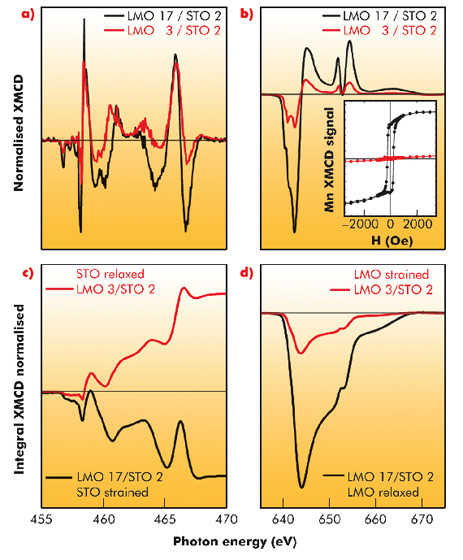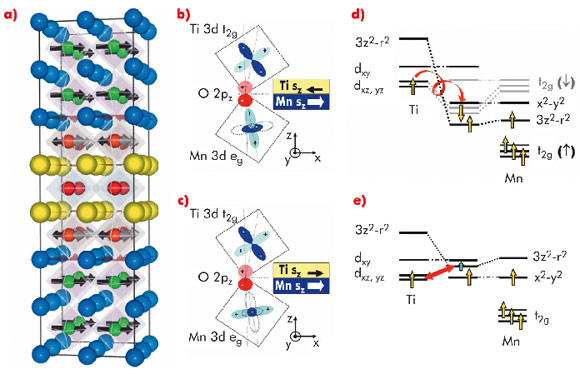- Home
- Users & Science
- Scientific Documentation
- ESRF Highlights
- ESRF Highlights 2010
- Electronic structure and magnetism
- Ti magnetism at LaMnO3/SrTiO3 interfaces
Ti magnetism at LaMnO3/SrTiO3 interfaces
Titanates and manganites share a common (perovskite) structure with similar lattice parameters, which allows the growth of high quality epitaxial interfaces. However, both systems are electronically very different. In manganites, the strong electron-lattice coupling lifts orbital degeneracy, which causes a null expectation value of the orbital moment. In titanates, orbital degeneracy due to the smaller Jahn-Teller distortions might allow non-zero values of the orbital magnetic moment. Novel forms of ferromagnetic superexchange interaction unique to t2g electron systems have been theoretically predicted [1], although their experimental observation has remained elusive. Experiments at beamline ID08 using X-ray magnetic circular dichroism (XMCD) have found a new kind of Ti3+ ferromagnetism at LaMnO3/SrTiO3 (LMO/STO) epitaxial interfaces. This results from charge transfer to the empty conduction band of the titanate and has spin and orbital contributions, evidencing the role played by orbital degeneracy.
We have grown LMO/STO superlattices on (100) oriented STO single crystalline substrates with atomically sharp interfaces using a high oxygen pressure RF sputtering technique. Atomic column resolution electron energy loss spectroscopy (EELS) shows the presence of Ti3+ at the interface plane [2] indicating a charge transfer mechanism. Samples have a magnetic moment as evidenced by strong XMCD signals at Ti and Mn edges (see Figure 80). Data correspond to two superlattices, one with 17 unit cell thick LMO and 2 unit cell thick STO [LMO 17/STO 2] and the other has 3 unit cells thick LMO and 2 unit cells thick STO [LMO 3/STO 2]. Figures 80c and d display the integrated area under the XMCD spectra for Ti and Mn edges. While the integrated area under the Mn XMCD spectra show that the orbital moment is essentially quenched as expected, there is an important orbital component of the magnetic moment of the Ti aligned antiparallel to the spin, evidencing the effect of spin orbit interaction (Hund’s third rule).
The shape of the XMCD signal of both the Mn and Ti depends strongly on the layer thickness ratio, and clearly indicate a change in the sign of the coupling mechanism of Ti and Mn spin moments at the interface from antiparallel for [LMO 17/STO 2] to parallel for [LMO 3/STO 2].
A simple (mean-field) molecular orbital picture provides a simple explanation for the magnetic coupling of Ti and Mn moments at the interface (see Figure 81). In the [LMO 17 / STO 2] superlattice there is strong hybridisation between the preferentially occupied Mn d(3z2-r2) band at the interface and the empty d(3z2-r2) band of Ti. The dominant superexchange process occurs between the Ti t2g electrons and the half filled Mn t2g bands, which is antiferromagnetic according to the Goodenough-Kanamori rules. In the [LMO 3/STO 2] superlattices there is no hybridisation between the occupied Mn d(x2-y2) and Ti orbitals across the interface. Ferromagnetic coupling in [LMO 3/STO 2] results from the superexchange interaction on Ti d(xz,yz)-Mn d(3z2-r2) bonds.
In conclusion, we have shown a novel form of Ti magnetism at a titanate/manganite interface. The magnetic alignment (ferromagnetic or antiferromagnetic) of Ti and Mn moments can be tuned by structural parameters. This result will provide important clues for the understanding of the effects of orbital degeneracy in superexchange coupling.
Principal publication and authors
J. Garcia-Barriocanal (a,b), J.C. Cezar (c), F.Y. Bruno (a), P. Thakur (c), N.B. Brookes (c), C. Utfeld (d), A. Rivera-Calzada (a), S.R. Giblin (e), J.W. Taylor (e), J.A. Duffy (f), S.B. Dugdale (d), T. Nakamura (g), K. Kodama (g), C. Leon (a), S. Okamoto (h) and J. Santamaria (a), Nature Comm. 1:82 (2010); DOI:10.1038/ncomms1080
(a) GFMC. Dpto. Física Aplicada III, Universidad Complutense de Madrid (Spain)
(b) SpLine Spanish CRG Beamline at the ESRF, Grenoble (France)
(c) ESRF
(d) H.H. Wills Physics Laboratory, University of Bristol (UK)
(e) ISIS Facility, Rutherford Appleton Laboratory, Chilton (UK)
(f) Department of Physics, University of Warwick, Coventry (UK)
(g) Japan Synchrotron Radiation Research Institute, SPring-8, Sayo (Japan)
(h) Materials Science and Technology Division, Oak Ridge National Laboratory, Oak Ridge (USA)
References
[1] T. Mizokawa, D.I. Khomskii and G. Sawatzky. Phys. Rev. B 60, 7309 (1999).
[2] J. Garcia-Barriocanal, F.Y. Bruno, A. Rivera-Calzada, Z. Sefrioui, N.M. Nemes, M. Garcia-Hernández, J. Rubio-Zuazo, G.R. Castro, M. Varela, S.J. Pennycook, C. Leon and J. Santamaria, Adv. Mat. 22, 627 (2010).





